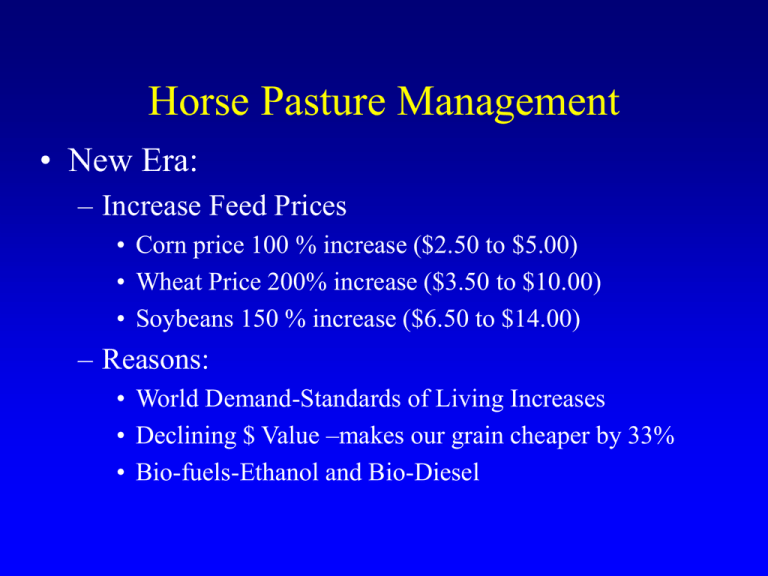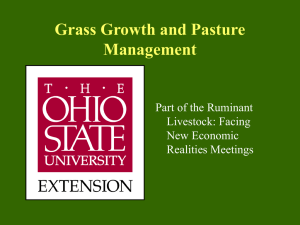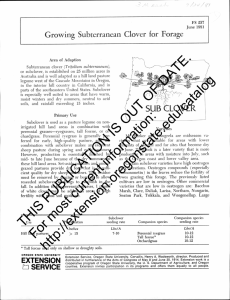Horse Grazing Opportunities 2008 (64 slides, 6144 KB .ppt)
advertisement

Horse Pasture Management • New Era: – Increase Feed Prices • Corn price 100 % increase ($2.50 to $5.00) • Wheat Price 200% increase ($3.50 to $10.00) • Soybeans 150 % increase ($6.50 to $14.00) – Reasons: • World Demand-Standards of Living Increases • Declining $ Value –makes our grain cheaper by 33% • Bio-fuels-Ethanol and Bio-Diesel Horse Pasture Management • New Era Affects: – Expect increases in Hay Prices • Current Hay Prices for Western Dairy Hay-$265/ton • Local Hay Supply very low-Little Carryover • Diesel Fuel is $4 per gallon-costs more to harvest and transport • Competition for acres-corn, wheat, soybeans • Winterkill of alfalfa in some areas • Land values increasing 15-18% last 5 years-in central Wisconsin Horse Pasture Management • Pastures for horses now need to provide more of the horses annual needs • Is it possible to graze horses on pasture from May-December? 8 months • Hay at $4-6 per bale in 2009 or forage costs of $2-3 per day for a horse Find Solutions to Feeding Horses • • • • Use grazing Buy hay during harvest Reduce inventory Feed limited amount – Control amount fed/day Grazing Formula Sunlight + Rain + Green Plants = Plant Growth Plant Growth + Grazing Animals = $$$ The Grazing formula involves: • What’s best for the grass • What’s best for the livestock • What moves you toward your goals!!! Traditional Pastures are often “Continuously Grazed” This usually means: – Lower yields – Serious weed pressure – Erosion problems – General “poor” management In Rotational Grazing... • Pastures are subdivided into smaller areas (or paddocks) • A portion of the pasture is grazed while the remainder “Rests” • Paddocks are allowed to: – Renew energy reserves – Rebuild plant vigor – Improve long-term production Intensive Rotational Grazing... Involves a higher level of management • Greater paddock numbers • Shorter grazing periods • Longer rest periods Many Pastures are Continuously Grazed W S This usually means: • Lower yields due to selective grazing • Greater weed problems • Potential for erosion problems in certain areas • No management or poor management of forage resource Rotational Grazing 1. Pastures are subdivided into smaller areas (paddocks) 2. A portion of the pasture is grazed Lane while the remainder “rests” Rest allows pasture to: • Recover from grazing, • Rebuild energy reserves & plant vigor • Increase forage production Management Intensive Rotational Grazing W W Corral Lane W W Management Intensive Rotational Grazing (MIRG) involves even greater numbers of paddocks and/or subdivision within paddocks to increase amount of rest and decrease days grazing each rotation Strip Grazing Recommened for fall pasture since no regrowth occurs Strip Grazing Corral S W Exercise Paddock S W Deitz, NRCS Deitz, NRCS Forage Quality Growth Best time to graze Curve Yield Seasonal growth patterns in forages Species Kentucky bluegrass Orchardgrass Reed Conarygrass Alfalfa Red clover White clover April May June July Aug. Sept. Oct. Monthly forage production in 2-acre grass and grass-legume pastures 3000 Lbs. Forage 2500 2000 1500 1000 animal need 500 0 May June July Aug. Sept. Oct. Grass Pasture Good Management Poor Management Grass-Legume Pasture Good Management Poor Management How much forage is out there? Rule of thumb: Figure about 400 pounds dry matter per acre per inch of cool season pasture. L. Paine The Rest Period • Should vary according to plant growth • In general, must increase as growth rate slows • Relates closely to seasonal forage growth • Need to rotate between paddocks every 3-6 days Relationship of rest period to pasture mass during periods of rapid vs. slow growth Optimum Lbs. Rest DM / acre Period 0 5 10 15 20 Period of fast plant growth (days) 25 0 10 20 30 40 Period of slow plant growth (days) 50 Stocking Rate (animals/acre) • Can use formulas for actual numbers • Thumb rule; one 1000 pound horse per 2-4 acres • Intensive Rotational Grazing = one mature, non-producing horse to 1-1.5 acres • Traditional “Under-managed” pastures = one horse to 5-10 acres Stocking Rate (animals/acre) • Can use formulas for actual numbers • Thumb rule; 1000 pound animal per 2-4 acres • Intensive Rotational Grazing = 1000 pound horse to 1-1.5 acres • Traditional “Under-managed” pastures = 1000 pound horse to 4-6 acres Which will cause more overgrazing? The stocking rate of both paddocks is identical: 100 Animal Days per Acre. The effect on the paddocks will be much different. How much do my animals need? Rule of thumb: Horses Figure 3 to 4% of body weight dry matter per animal per day. L. Paine Pasture Needs Calculation • 1000 horse needs-3.5% of body weight – Pasture is 8 inches tall – Graze to 3 inches • 5 inches x 400 lbs/inch=2000 of DM forage • 2000 divided by 35 lbs(needs per day)=57 days of forage – Pasture can supply 2 months of grazing Forage Plots Results Central Wisconsin • Established in May 2000 – Twenty(20) grass and legume mix combinations – 4 replications in Adams County (80 plots – 2 replications in Waushara County at Hancock Research Station – Mix grass and legumes based on height – Harvest mechanically and graze White clover x Kentucky bluegrass Short 2. White clover x Crested wheat grass Short 3. Kura clover x Kentucky bluegrass Short 4. Kura clover x Crested wheat grass Short 5. Kura clover x Smooth brome grass ½ Short x ½ Tall 6. Birdsfoot treefoil x Kentucky bluegrass Short 7. Birdsfoot treefoil x Crested wheat grass Short 8. Red clover x Timothy 9. Red clover x Tall fescue 10.Red clover x Meadow fescue 11.Red clover x Smooth brome 12.Red clover x Orchard grass 13.Alfalfa x Orchard grass 14.Red clover x Alfalfa x Orchard grass x Smooth brome Tall 15.White Clover x Kura clover x Kentucky blue grass Short 16.Red colver x White clover x Kentucky blue grass x Smooth brome Short x ½ Tall 17.Kura clover x Birdsfoot treefoil x Timothy x Orchard grass Short x ½ Tall 18.Alfalfa x Red Clover x Kentucky blue grass 1/3 Short x 2/3 Tall 19.Red Clover x alfalfa x Kura Clover x Timothy x Smooth brome x Tall fescue 1/3 Short x 2/3 Tall 20. White clover x red clover x Birdsfoot treefoil x Kentucky bluegrass Tall Tall Tall Tall Tall Tall Forage Yield Central Wisconsin • White Clover and Kentucky Blue grass •Both are short-less than 16 inches •Tendency to go dormant in hot dry weather •Yield-average 1.47 tons/acre at 22% protein Forage Yield Central Wisconsin • Red Clover and Timothy •Both are tall •Early growth and Greenup •Timothy only grass to grow seed head after cutting •Yield-average 2.58 tons/acre at 18.1% protein Forage Yield Central Wisconsin • Red Clover and Tall Fescue •Both are tall •Early growth and Greenup, good fall regrowth •Tall fescue is good sod former, endophyte free •Yield-average 3.65 tons/acre at 19.5% protein Forage Yield Central Wisconsin • Red Clover and Meadow Fescue •Both are tall •Early growth and green-up •Meadow Fescue very winter hardy •Horses and cattle preferred meadow fescue mix •Yield-average 4.12 tons/acre at 20.6 % protein Forage Yield Central Wisconsin • Red Clover and Smooth Brome •Both are tall •Early growth and green-up •Spreads by rhizomes, sod former •Yield-average 3.98 tons/acre at 19.5 % protein Forage Yield Central Wisconsin • Red Clover and Orchard Grass •Both are tall •Early growth and green-up •Excellent Fall Re-growth •Orchard Grass is a bunch grass •Yield-average 4.26 tons/acre at 20.1 % protein Forage Yield Central Wisconsin • Alfalfa and Orchard Grass •Both are tall •Early growth and green-up •Excellent Summer Growth and Fall Re-growth •Orchard Grass is a bunch grass •Yield-average 3.57 tons/acre at 19 % protein Forage Yield Central Wisconsin • Red Clover, Alfalfa, Smooth Brome & Orchard Grass •Tall Combination •Early growth and green-up •Excellent Summer Growth and Fall Re-growth •Yield-average 3.74 tons/acre at 20.2 % protein Forage Yield Central Wisconsin • Alfalfa, Red Clover, and Kentucky Blue Grass •Combination • Excellent re-growth and persistent •Yield-average 4.23 tons/acre at 16.8 % protein •Highest Yielding plot in test Forage Yield Central Wisconsin • Establishment-Cost of seeding only, no seed cost – – – – – Tillage-plow, disc, drill-cost of $40-50 per acre Direct seed-$15 No-till drill-$12 Frost seeding-$5 Manure seeding-$0-$1 Forage Yield Central Wisconsin • Establishment-Seed Cost – In most soils we need 15-20 lbs of seed per acre – Consider cover crop of oats with drill seeding – Frost seeding requires short grass conditions and control of competition-grazing or mowing – Graze cover crop in Mid-June Forage Yield Central Wisconsin • Establishment-Seed Cost- From Select Catalogs 2004 – – – – – – – – – – Alfalfa= $1.75-$4.00 per pound Red Clover=$1-$2.50 per pound Kura Clover=$4.00-$5.00 per pound White Clover=$2.00-$4.00 per pound Kentucky Blue Grass=$1.50-$3.00 per pound Orchardgrass=$1.00-$3.00 per pound Brome grass=$1.00-$2.00 per pound Tall fescue=$1.00- $2.50 per pound Meadow fescue=$1.75-$3.00 per pound Timothy=$0.75-$1.50 per pound Forage Yield Central Wisconsin Establishment-Seeding Rates Recommendations Species Seeded Alone Mix – – – – – – – – – Alfalfa Kura Clover White Clover Kentucky Blue Grass Orchardgrass Bromegrass Tall fescue Meadow fescue Timothy 15 lbs 8 lbs 14 lbs(not recommended) 15 lbs 10 lbs 16 lbs 10 lbs 10 lbs 8 lbs • Do not apply more than 20 lbs of seed mix per acre 8 lbs 4 lbs 2 lbs 10 lbs 4 lbs 6 lbs 4 lbs 4 lbs 4 lbs FROST SEEDING Adding new seed to a pasture by broadcasting on frozen ground in early spring, letting frost & snow incorporate the seed. Snow Tracks Help Frost Seeding in Snow Frost Seeding Snow Tracks Help FROST SEEDING • Improves Pasture Quality & Yield • Lower Cost Than Annual Nitrogen Application ($9 vs. $42) • Works Best On Loams & Clay Soils or Fields With Natural Moisture • Clovers Recommended, Birdsfoot Trefoil & Certain Grasses Can Work Horses & Pasture • A grass-legume pasture can produce enough to meet the maintenance requirements of most adult horses • In general, horses are more destructive to pasture than cattle • Horses are natural “nibblers” Horses & Pasture A Pennsylvania study showed horses preferred: • Grasses over legumes • Bluegrass over taller grasses • Clovers over alfalfa and birdsfoot trefoil The study also showed that horses’ made satisfactory progress on all pasture mixtures If at all possible graze cattle with horses Because: • It reduces parasitic infestation • Each will eat around the others’ droppings • It assures more uniform use of the pasture • Cattle will graze otherwise wasted feed Diet Selection of Livestock Type Horses Cattle Sheep Goats ---------- % of diet ---------- Forage a 90 70 60 20 Weeds 4 20 30 20 Browse b 6 10 10 60 aA b mixture of grass and legumes Woody material Grazing Management Tips • For rotational grazing to be successful you must be flexible • If you don’t want to make hay during periods of rapid forage growth, move animals faster • Provide free choice salt & minerals Grazing Management Tips • Avoid over or under grazing • Clip pastures regularly during the growing season • Drag pastures with a chain link harrow at least once per year • Apply fertilizer as needed (take a soil test) • Re-seed pastures if necessary http://www.uwex.edu/ces/crops/teamforage/index.html •Thanks for Your Attention




